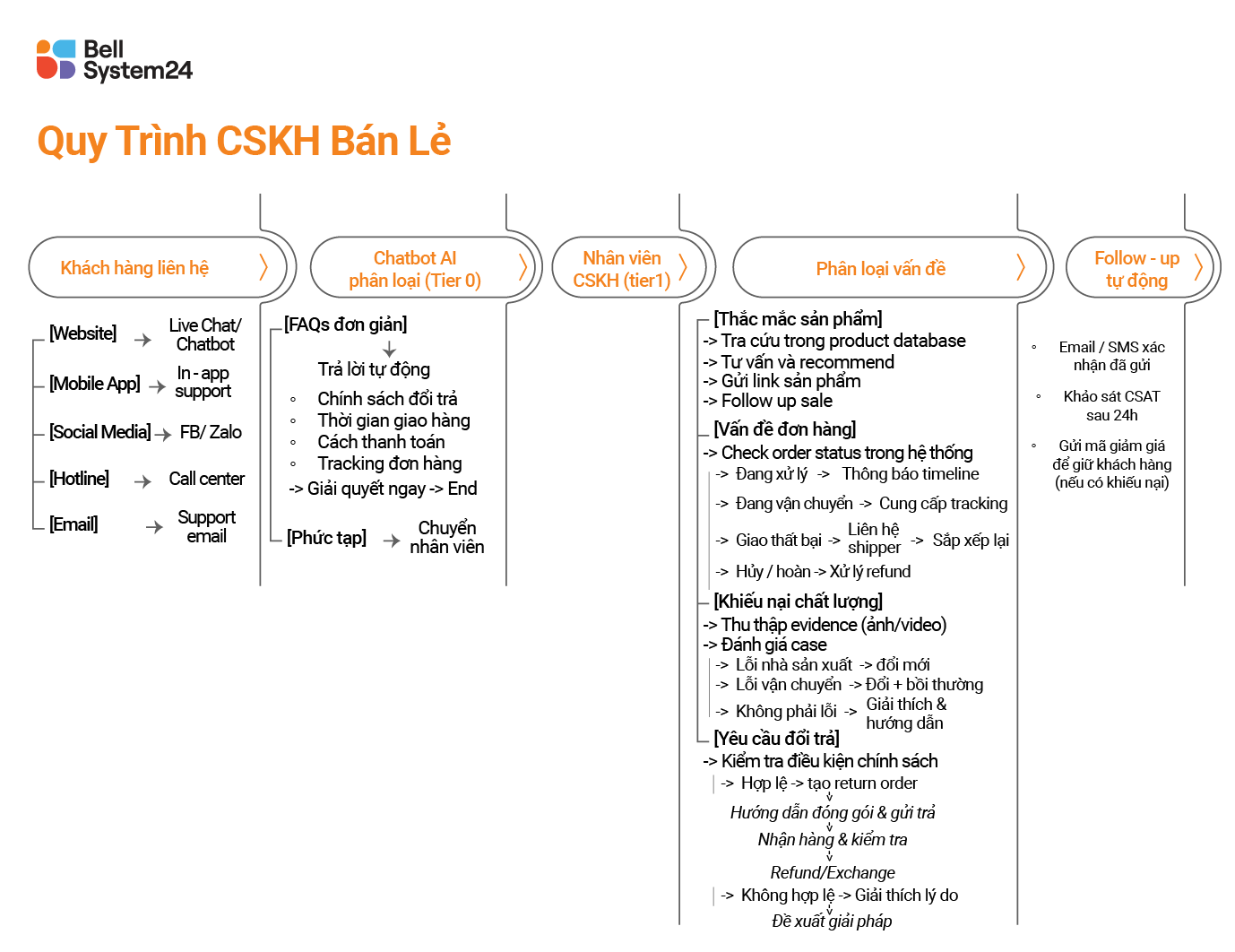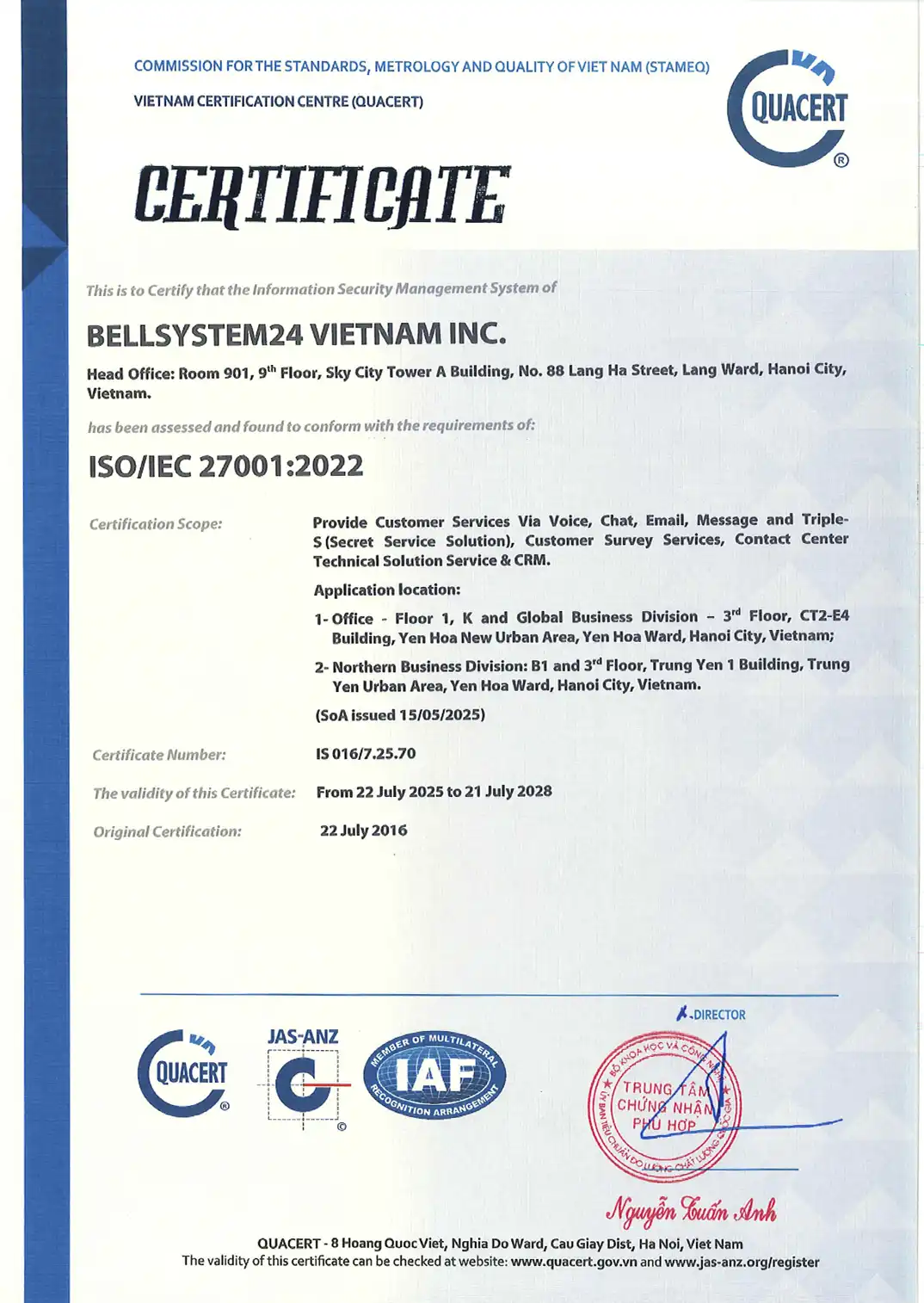The Contact Center trend is booming, with a market size reaching a total value of 339.4 billion USD in 2020, according to Statista. It is predicted that by 2027, the industry will continue to grow steadily, reaching 496 billion USD. With this strong growth rate, businesses need to quickly update new trends so as not to miss the opportunity to accompany and develop with Contact Center in the next decade.
Contact Center Trend 1: Contact Centers Will Be Considered as “Relationship Hubs”
This Contact Center trend is changing the way businesses view the role of the Contact Center in their customer relationships. When a problem occurs, Contact Center employees (Agents) are often the first to know. They not only solve the problem but also act as a bridge between the customer and other departments in the business such as sales, distribution, marketing, development, and product management.

You may be interested in: Agent Training in BPO Industry at Bellsystem24 Vietnam
According to a Deloitte report, 62% global businesses have transformed their Contact Centers into strategic “hubs” to build and maintain customer relationships. They not only handle complaints but also proactively provide information, collect feedback and propose solutions to improve customer experience. A Salesforce study also showed that 78% customers believe that consistent and personalized experiences at Contact Centers are important to keeping them loyal to the brand.
For example, Amazon has used its Contact Center as a “Relationship Hub” by integrating AI technology into its customer care process. This allows employees to resolve issues quickly while collecting data to improve products and services. As a result, Amazon recorded a customer satisfaction level of 91% in 2022, far exceeding the industry average of 81% (according to ACSI).
Clearly, Contact Center is not only a place to solve arising problems but is becoming a strategic center for businesses to build loyalty and sustainable development.
Contact Center Trend 2: Customer Service Representatives Have More Power!
Customers today are becoming more knowledgeable and self-reliant. Many will look for answers on forums or community groups. Therefore, they will tend to only call the hotline when they encounter a really “difficult” problem. Customer service staff will need to be well-trained and well-prepared to be able to help customers solve problems when they call.
According to a report from Microsoft, 90% customers expect businesses to provide self-service capabilities, and only contact the Hotline when encountering truly “difficult” problems or problems that cannot be solved by themselves. This makes the role of customer service staff (CSKH) in the Contact Center more complex but also more strategic than ever.
To meet the modern Contact Center trend, customer service staff need to be well-trained and fully equipped with the skills to handle any situation. The necessary skills include: good communication skills to build trust with customers, quick analysis and problem-solving skills, along with in-depth knowledge of products, services or related technical issues. In addition, flexibility and agility in using modern Contact Center systems, such as data-integrated CRM, also play an important role. According to a Salesforce study, 79% customer service staff feel that advanced support technology helps them solve problems more effectively and provide a better customer experience.
A practical example is Apple, where customer service staff are trained to use customer information management systems effectively and are given greater decision-making authority in handling complex cases. As a result, Apple has achieved a customer satisfaction rate of 93% (according to ACSI), much higher than the industry average.
The current trend in Contact Centers requires customer service agents to not only be excellent problem solvers, but also to be close connectors between businesses and customers, creating personalized and positive experiences. This is the key for businesses to build loyalty and maintain a competitive advantage in an increasingly fierce market.
Contact Center Trend 3: Intelligent Call Routing
In fact, smart call routing has been around for a long time and is becoming more and more popular.
For example: When a customer calls the Hotline, the System will automatically route and connect the call to the most suitable operator. This can be through skill-based routing or case-owner routing. In addition, users can also request a specific operator who has supported them before. The customer's waiting time will be shorter and the operator with the most suitable skills will be prioritized in the waiting line.

Reference: Case Study using IVR and Integrated Multi-Channel Switchboard
Contact Center Trend 4: Web chat becomes a popular customer service channel
In the modern Contact Center trend, web chat is gradually becoming a popular and indispensable customer care (CSKH) channel. Today's customers no longer want to wait long for support, instead, they tend to engage in live chat to quickly resolve problems. According to a report by Zendesk, 85% customers feel more satisfied when receiving support via web chat because of the convenience and instant response. In particular, this form of support not only increases flexibility but also brings a sense of reliability when customers can chat or even make video calls with the appropriate CSKH staff.

Reference: Video Contact Center – Weapon to enhance customer experience
In addition, the Contact Center trend does not stop at a single channel but is strongly shifting to the Omnichannel strategy - multi-channel customer care. With Omnichannel, customers can approach businesses through many different platforms such as social networks, email, phone, mobile applications, and even web chat. This meets the increasing demand for seamlessness and accuracy in customer care experiences. According to research from Harvard Business Review, 73% customers use multiple channels to interact with businesses, and they expect a consistent experience regardless of the touchpoint.
Trend 5: Cloud Contact Center, Remote Agents and Location-based service
Cloud Contact Center and Remote Agents have been highly effective Contact Center operations for businesses during the Covid period, and promise to continue to be useful solutions in the future, helping businesses save on labor costs and increase internal flexibility. With Cloud Contact Center and Remote Agents, managers can still effectively monitor and manage their teams.
According to a report from Contact Babel, implementing a Cloud Contact Center can reduce operating costs by up to 27% compared to traditional models. By migrating to the cloud, businesses can cut costs related to infrastructure, system maintenance, and on-site operations. In particular, Remote Agents also help businesses save significantly on personnel costs, such as travel and stationery costs, while expanding recruitment capabilities to remote areas without being limited by geographic location. For example, at a large European enterprise, implementing a Cloud Contact Center increased the First Call Resolution rate by up to 35%, thanks to the flexibility in work distribution and remote support. Another great example is global insurance company Zurich, which saved over $3 million per year by adopting Remote Agents, while reducing claim processing time from 48 hours to 12 hours.
Customers will also have faster, more convenient interactions and a better experience. For example, a customer who calls can be automatically connected to a remote agent just a few miles away, so the agent can visit the customer immediately if necessary, or know the geographic area to support the customer.
Trend 6: Smart IVR, AI, virtual resources and intelligent tools
Applying AI in Contact Center helps businesses handle common problems without human interaction. For example, AI can support directions, notify store opening hours, buy prescription drugs, automatically understand and converse with customers, etc. Other automation features such as Smart IVR (Automatic voice call answering system), Auto Dialer (Automatic dialing), Auto Call (Automatic calling) help save significant costs, time and resources for businesses.
In addition, automation features such as Smart IVR, Auto Dialer, and Auto Call not only increase operational efficiency but also optimize costs and resources for businesses. According to research from Gartner, implementing AI in Contact Centers can reduce annual operating costs by up to 30%, while significantly improving customer satisfaction thanks to fast response speeds. In some industries, AI can even increase efficiency by up to 40% thanks to its ability to predict and analyze data to provide accurate solutions in real time. These technologies not only create competitive advantages but also contribute to building a professional and modern brand image in the eyes of customers.
Trend 7: Businesses are forced to focus on building customer service
With the proliferation of multi-channel communication methods and increasing demands from customers, customer experience is becoming increasingly important, creating competitive capabilities for businesses. The development of social media can transform customer service experiences from 1:1 interactions between buyers and sellers to public on social networks at a rapid pace.
Poor customer experience causes half of consumers to switch to a competitor.
Trend 8: Mobile and flexible
Mobile can accommodate multiple ways for customers to contact you – via email, live chat, social media, or video call.
Companies need to optimize their apps for mobile – especially by allowing customers to multitask on their mobile devices. For example, they can read an FAQ page while on the phone with a call center agent.
Customer service staff also need to be able to work on mobile devices: access the CRM system, look up data and customer information to support them quickly, and interact positively with customers. Employees/Agents can work flexibly remotely, anytime, anywhere on mobile devices with Internet connection. Management can also monitor the performance of both the Contact Center and each employee/Agent.
Trend 9: Multi-channel and flexibility in contact methods
In the context of the growing Contact Center trend, providing flexible and diverse contact channels has become a core factor for businesses to maintain a competitive advantage. A typical example is WhatsApp, a messaging platform launched in 2009, which has now reached more than 2 billion global users. This is not only a personal communication tool but also chosen by many businesses as an effective customer service channel. Typically, Aramex, one of the leading enterprises in the field of international transportation, has integrated WhatsApp into its Contact Center system, helping to increase customer interaction and improve operational efficiency. According to a report from Business Wire, the use of WhatsApp has helped Aramex increase customer response rates by 25% and reduce request processing time by 18%.
The ability to adapt to changing customer needs is a key factor in the success of the Contact Center in the future. This is especially important for businesses looking to conquer younger customers – who often switch between channels such as web chat, email, voice calls, and social media in a short period of time. Flexible integration of contact channels not only creates a seamless experience, but also helps businesses maintain customer satisfaction and loyalty, while opening up opportunities for revenue growth in a competitive market.

Contact Bellsystem24 Vietnam now for advice, Tailored Contact Center solution with integrated CRM with leading technology today
Trend 10: Voice Biometrics Will Replace Security Questions
“What is your mother’s maiden name?” is one of many common security questions, but in the next ten years, it will be more about how customers answer a question than the answer itself that confirms their identity.
In fact, reproducing a human voice is much more difficult than answering questions about a customer’s personality. That’s because voice biometrics is a sophisticated system that captures the complexities of the human voice, from determining the size and shape of the mouth to measuring the tension of the vocal cords.
Trend 11: The “Internet of Things” Network
The growing number of mobile devices that can connect to the Internet has created a world where almost everything is connected. With the Contact Center system, this allows businesses to provide priority service to each customer with the highest level of personalization.
For example, if a patient's heart monitor overheats, the device could immediately send an automated service request to the appropriate team. Or a washing machine could automatically recognize and notify the manufacturer when parts need to be replaced or repaired.
As such, consumer attitudes will change. Instead of buying a product that meets their usual needs as before, they tend to spend more on services, products that integrate smart additional features or come with valuable after-sales care programs.
Trend 12: Robotic Process Automation (RPA)
Contact centers that rely on legacy systems are often slow to navigate and require agents to take multiple steps to complete basic tasks. This can lead to frustrated and impatient callers.
Robotic Process Automation (RPA) has emerged as a revolutionary solution that simplifies the configuration, deployment, and management of robotic software that operates on digital platforms. These robots are capable of handling repetitive tasks quickly, accurately, and without interruption, thereby optimizing Contact Center operations. As a result, businesses can significantly reduce work processing time and personnel costs, while improving overall operational efficiency.
Not only does it automate the call center, robots also have the ability to support and guide agents in their work. From the initial operations, robots provide specialized training modules, helping agents quickly get acquainted with the processes and effectively handle basic tasks. At the same time, RPA also supports recording detailed notes from each call and providing real-time information, thereby improving the customer experience. For example, at a large Contact Center in Europe, RPA implementation improved agent productivity by 30%, while increasing the request resolution rate on the first contact to 25% (according to Forrester).
By applying RPA to operations, businesses not only gain cost advantages but also significantly improve customer satisfaction and loyalty. These improvements not only strengthen their competitive position in the market but also open up opportunities for sustainable development in the future, especially in the ever-changing customer service industry. RPA technology is truly an important step forward, helping to realize the goal of building a smarter, more flexible and efficient Contact Center than ever before.

With 17 years of experience working with hundreds of partners in many different fields, Bellsystem24 Vietnam is proud to be a pioneer in leading the trend of modern Contact Center, constantly upgrading the quality of operations and technology to bring the most optimal solutions.
We always put customers and agents at the center, building Contact Center not only as a place to support services but also as a center to create outstanding competitive advantages for businesses. Our mission is to turn the Contact Center trend into a strategic tool to help businesses go further.
Bellsystem24 Vietnam is committed to continuing to maintain its leading position in the Contact Center & BPO field, providing specialized, flexible, and effective solutions to help optimize costs and resources. We are always a reliable partner, accompanying businesses on their journey to success.
English
“>”>







